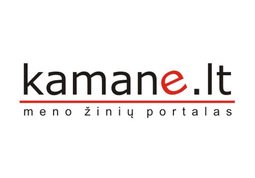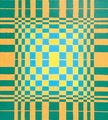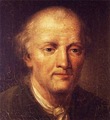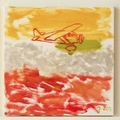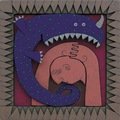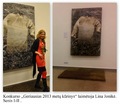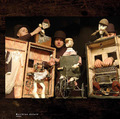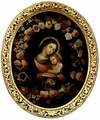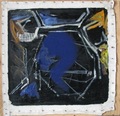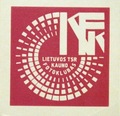Odyssey of love to ceramics. Story of ceramicist Aldona Keturakienė 2014-09-10
The recently interviewed ceramicist Prof. Aldona Keturakienė (b. 1945) may tell many memorable stories, which are met in literature more often than in real life, from any period of her life. As the artist told her biography coherently (from adventures at Ukmergė kindergarten, secondary school, family and starting to live on one’s own to independent choice of education and studies at various Lithuanian art institutions), in the article the entire period of younth and creative searches of the artist (in the period of 1961–1973) is reviewed.
Abstractions of photography and painting – in one rhythm 2014-09-04
The exhibition of photography and painting abstractions “Rhythms” was open at Kaunas City Municipality Vincas Kudirka Public Library in August. The initiators of the exhibition were the art photographer Vilija Kailiūtė and painter Antanas Andziulis.
Biases of interwar city planning heritage 2014-08-21
We are often misled by material artefacts of the past. The harmonious development of the city is always defined by the dichotomy of tradition versions novelty. Novelty should be introduced into tradition in time so that it could become tradition in its turn. It would be the logical change of the city organism.
Italy in life of Lithuanian painters 2014-08-18
When we speak about painting in Lithuania, first of all we mention Mikalojus Konstantinas Čiurlionis (1875 – 1911) and forget that the genesis of our art is much older and more colourful. Interesting stories may be found while making researches that may equal to the world history of art. Some Lithuanian painters are known not only in Lithuania but in the world too, they had a chance to “touch” the heritage of the great artists. And all of them are united by the cradle of art Italy.
Judita Budriūnaitė: “From pilot’s road where I live” 2014-08-12
The conversation with the artist J. Budriūnaitė is presented about the exhibition “From Pilots’ Road” displayed at Kaunas Picture Gallery presently, creative choices, new decisions, ideas, life in exhibitions as a group member and return in thoughts to the exhibition “Names of the Break Generation” of 2000.
The book about the last Barbora 2014-08-07
The review of the book compiled by Svajūnas Sabaliauskas “Rūta Staliliūnaitė. I am Barbora. Recollections about the Queen of Stage” (Obuolys Publishing House) is presented. As the book consists of memories about the late actress, memories can hardly be reviewed, the author marks. And the book is as valuable as people who remember Rūta in their stories are interesting.
About postmodern phenomena of classics 2014-07-09
The title of the most creative book was granted to “Lives of Saints” (“Šventųjų gyvenimai“) of Romualdas Granauskas in 2013 for the most solid characters, who surprised by contemporary man by the principle of special harmony. The success of the writer encouraged the group of literature critics Žirklionis to analyse the later works of R.Granauskas and the changes that may be noticed in them.
Waking up the sprite – conversation with townscape specialist V.Buinevičius 2014-07-01
Like a number of other objects located more remotely from the main streets of Kaunas, Kaukas Stairs leading up to Žaliakalnis quarter and the pool located on the hill near the stairs are quite forlorn and forgotten by the city inhabitants.Still, differently from other objects of similar fate, the space called by the name of Kaukas (sprite in English) is able to interest and charm even people who are too young to remember the beautiful times of Kaukas Stairs.
Between myth and reality: defensive walls of Kaunas city 2014-06-05
The construction of city walls became popular in the 12th-15th century. Defensive walls became an inseparable sign of an autonomic and flourishing city. Two cities which had or still have defensive walls are present in the present territory of Lithuania – it is Kaunas and Vilnius. The main theme of this article is the defensive walls of Kaunas city; therefore, reinforcements of Vilnius city are not be analysed more extensively in the article.
Artist V. Tamoševičiūtė: “Performance Happens Here and Now” 2014-05-19
In brief: Interview with one of the brains behind Kaunas festival “CREATurE Live Art” (May 29–June 1, performance art studies May 20–June 2) – performance artist Vaida Tamoševičiūtė. Vaida and Aušra talk about festival participants, schools of performance and interesting Lithuanian and foreign performance artists.
What do you want to say by that?.. 2014-05-05
According to K.Šapoka, the title of the exhibition “Concerns and Expectations” is an ironic allusion to the artificial style of Soviet times. “We suggest to the viewer that he/she should not regard these works too seriously. Still, we turn back to the Soviet times not to dig in the waste yard of history but in order to pay attention to the Soviet times which continue until today."
Lawyer of characters Vainius Sodeika: to win the viewer without a flip 2014-04-23
The list of clients of Vainius Sodeika (b. 1986) includes sellers of cars and drug dealers, children of asocial families and such personalities as Guillaume Apollinaire, Tyler Durden, Serhiy Zhadan, Aksentij Popryshchin, member of Nobel committee Kaare Sandegren, former prime minister of Lithuania Albertas Šimėnas and even Leonidas Donskis.
Three architectural giants of faith 2014-04-17
Speaking about Lithuania, two giant buildings which became the symbolical relics of our culture may be distinguished – St. Jesus Heart Church in Vilnius and the Christ’s Resurrection Church in Kaunas. The Christ’s Resurrection Church is located in Kaunas, it is the symbolic image of the city. After Lithuania regained its independence, Prof. priest Pranas Būčys (1872 – 1951) offered an idea to build a temple – a monument for independence in 1922.
On both sides of prison 2014-04-14
The project “Made Corrections” was born from the informal discussion of two British artists David Ellis and Dean Stalham about the self-awareness, identity, social status and possibilities to change of imprisoned people. Three years ago both artists decided that actions were more important than words.
Gambling behind the glass 2014-03-24
It seems that the participation of the film “The Gambler” of the director Ignas Jonynas in San Sebastian Film Festival is a greater event than the film itself. The film was selected by the director of the festival Jose Luis Rebordinos to the list of eight films which represent the festival.
Expressive interwar architecture 2014-02-21
It should be emphasised that Kaunas experienced the real triumph of architecture in the interwar period. A big number of modern buildings appeared in the city in the interwar period, when it was the temporary capital of Lithuania. 10 581 buildings were constructed in Kaunas in 1918–1938. Neoclassicism and various free interpretations were the most popular.
What artists spoke about in 2013 2014-02-19
The phrase of the competition organisers “All are accepted” makes it understandable to any visitor of the exhibition “The Best Artwork of the Year 2013” organised at Kaunas Picture Gallery that there are no criteria – one theme or idea, concept, performance technique or any other frames that artists should lean upon. The only condition for the participants is that the artwork should be created in 2013.
New page in Kaunas art history – book about artist Elena Jakutytė 2014-02-17
Kristina Budrytė-Genevičė collected factual data about the artist Elena Jakutytė from archives, spoke with friends of the artist and established relations with her relatives in Australia. The road of the artist’s life was restored on the basis of the collected facts. The story presented by Genevičė is consistent, chronological, there is almost no space for wide interpretations in it.
Vanishing wooden Kaunas: case of Higher Šančiai in Kaunas 2013-12-12
Looking at the collected information, it may be asserted that there is some well maintained and tidied wooden architecture not only in Žaliakalnis, Panemunė, but also in the Higher Šančiai quarter in Kaunas. Of course, the examples of untidy, poorly maintained or completely unattended wooden houses prevail in the analysed territory, but their presence does not devalue the perfectly maintained wooden houses; on the contrary, such houses gain more significance in such a background.
Community in Lithuanian city. Mission impossible? 2013-12-11
The huge disjuncture of inhabitants of Lithuanian cities is felt in each square meter of the city. What is the role of architecture in this situation? Does it decrease or increase this disjuncture? Can it serve as an element uniting the society and what should be changed for this to happen?
Starting with wedding based on calculation, ending with sharing of legacy 2013-12-06
The rejoicing fact is that the repertoire of Kaunas State Musical Theatre replenishes with new stagings of operas every year. Still, these two operas in particular, “The Marriage Bill” and “Gianni Schicchi”, provoke a twofold evaluation.
What is stronger than black? 2013-12-06
The selection of poems of Valdas Gedgaudas “Stiprėjanti Juoda“ (Black Getting Stronger, Homo Liber, 2013) is reviewed in the article. The author was encouraged to find the book of V. Gedgaudas due to its juvenile and sentimental title. Is there nothing stronger than black when you are 51 years of age?
Insects as actors in 1910-2013: from animation of V.Starevich to photography of L.Jonaitis 2013-12-02
Cinema and photography are two different art kinds that have much in common. Two different artists, Vladislav Starevich and Lukas Jonaitis, were related by interest in entomology. V.Starevich was a famous filmmaker, father of stop-motion animation, author of many film scripts, actor. LJonaitis is a young photographer who has been creating macro photographs for some time and capturing representatives of insects and spiders’ world.
Ina Pukelytė: “Craft is not enough for an actor” 2013-12-02
“Craft is not enough for an actor, he/she has to take interest what new happens, what experiments are made, how people go further. The spectator comes to look at a thinking actor, not only masterful. He/she is interested what an actor wants to say about life here and now or in future and not how he/she does it. The tradition of a live actor rather than functional is more significant,” the theatre critic I.Pukelytė states.
Poetess Enrika Striogaitė: “I live trying to leave no trace” 2013-11-30
The author meets the poet, journalist and creator of documentaries Enrika Striogaitė all the time – in a cold cinema, behind plastic wine glasses in an exhibition, in a presentation of a book at the door, in an old manor. Being everywhere she still remains unseen.
Attitude to Vitas Luckus 2013-11-20
It is the author’s small hommage to the man whom he did not know personally but with whom he got acquainted closely through his own words. Going through pages of the book compiled by Margarita Matulytė and Tania Luckienė-Aldag and dedicated to the photographer Vitas Luckus and his works, the author could not get rid of the feeling that he recognised some of his contemporaries surrounding him. This hommage is indirectly addressed to them too.
Puzzle of daily life 2013-11-11
Aistė Kisarauskaitė is an artist, photographer who organises various exhibitions and contemporary art projects. The author has been publishing short prose works, articles and essays in weeklies Šiaurės Atėnai and Literatūra ir Menas since 2003. “39 Salto Mortale” is the first book of short prose works of A. Kisarauskaitė, and it participates in the Election of the Book of the Year 2013.
Manifestations of magic realism in novel of Elena Kurklietytė “Šešėlių Verpėja” 2013-10-28
More and more works of literature are published recently that could be attributed to magic realism. Such works involve, provoke and surprise the reader by the harmony of antitheses. Manifestations of magic realism may be traced in the works of the Lithuanian journalist and writer Elena Kurklietytė. As for the magic realism, two of her novels “Lyla” (2004) and “Šešėlių verpėja” (2009) (“Spinner of Shadows”) should be mentioned.
Inexpedient supplement of Kaunas Biennial or its part? 2013-10-23
The segregated, outcasts or one of the composite parts of Kaunas Biennial Unitext? An equal exhibition, only in different space, or shadow of the grand competitive exhibition at M.Žilinskas Gallery? There are more questions that arise while visiting the young artists’ exhibition at Kaunas Picture Gallery…
Pioneer of Egyptology M.Rudzinskaitė-Arcimavičienė. Signs of Egypt in Lithuanian art 2013-10-21
The contribution of Marija Rudzinskaitė-Arcimavičienė (1885 – 1941) into the forming Egyptology of Lithuania is rather marked. This scientist is often called “the pioneer of Egyptology” as she introduced the Eastern culture to Lithuanians in the 20th century. After her death no one appeared who could have continued the started work consistently. On the one hand this was determined by political circumstances, on another hand – by the lack of interest of the public.
Route “Progressive Kaunas Architecture” 2013-10-08
The excursion “Progressive Kaunas Architecture” was organised in Kaunas by scientists of the Architecture and City Planning Research Centre (AUTC) Dr. Vaidas Petrulis and post-graduate student Kastytis Rudokas on the last weekend of September. The excursion was attended by a big number of Kaunas inhabitants and guests of the city.
To transform (oneself) 2013-10-07
Enthusiasts and masters of photography commemorated the birth centenary of Povilas Karpavičius (b. in 1909 in Tbilisi – d. in 1986 in Kaunas) in 2009, the exhibition “Maestro Povilas Karpavičius (1909–1986)” was organised in Riga and biggest Lithuanian towns. Many publications dedicated to the master appeared in the press and it was emphasised how important it was to restore history of Lithuanian photography in detail, without forgetting photographers who used non-standard techniques. Still, after the jubilee year the personality and works of P. Karpavičius was forgotten little by little again.
Vita Mozūraitė: “The strongest dance troupe is in Kaunas” 2013-10-07
The international dance festival Aura'23 was organised in Kaunas on September 18-22. It was presented as a platform of African contemporary dance to the audience, although works of western troupes were also shown. As emotions faded away slightly after the festival, the dance critic Vita Mozūraitė was asked to review and comment the seen performances. The interlocutors could not distance from thoughts about the Lithuanian dance scene and the only Lithuanian dance theatre in the conversation.
Odysseus never returned 2013-09-23
Speaking about the return, the poet denies all possible impications – it is not possible to return and to step to the same river twice. According to J. Mekas, Odysseus never returned home. On another hand, J. Mekas loves oxymorons: it is impossible to return physically but you can always return while creating - it is unavoidable. The majority of poetry and cinema works of J.Mekas are created on the basis of this assumption.
Kaunas before the fortification (facts and interesting details) 2013-09-10
Kaunas stood out by its history from ancient times in Lithuania. The king Henrikas Valua (1551-1589) called Kaunas the jewel of the Republic of Two Nations. In the middle of the 16th century – second half of the 17th century the period of its existence is called “Republic of Kaunas” – this reflects the municipality of the city, the quality of participation of inhabitants in the city life and management, which was strived for by other Lithuanian cities.
Romualdas Rakauskas: “Your works reveal your inside” 2013-09-05
The conversation with the art photographer Romualdas Rakauskas takes place during the European Basketball Championship. The photographer is a passionate admirer of basketball, he has issued two albums with Romualdas Požerskis “Men of Žalgiris” (1987) and “Legendary Men of Žalgiris” (2011). The artist is asked what team of Lithuanian photographers he would rally in order to play basketball.
The cat that came 2013-09-02
“The Cat I Needed” of S. Bernotaitė is a gloomy and grey novel at the first glance without a clear denouement. Still, it cannot be forgotten with time. It is not only about the internal change of one unhappy woman or about a painful family drama. It reminds that there are people whose fate was broken by the rotten Soviet system. It is a novel about stereotypes, searches of internal freedom and loneliness.
About contemporary novels, romances, stories and prose crowns 2013-08-27
In the discussion about literature the interlocutors analyse the interesting tendencies that may be observed in Lithuanian prose lately. Attention is drawn by the tendency to call genres by unusual labels. Another topic of discussion is the post-modern problem of transience and uncertainty of meaning.
Art photographer Algimantas Aleksandravičius: “I am the thief of souls” 2013-08-26
The art photographer Algimantas Aleksandravičius is interviewed after viewing his newest exhibition “From Fado to…” (Vilnius, Prospekto gallery), in which faces of famous Lithuanian people and photo shots of various European cities may be seen. He was earlier announced the best portraitist of Europe (2003) and Baltic States (2011). In the interview the artist speaks about the creation of portraits, variety of his photographs, tendencies and change of photography today.
Fake realities of Renata Vinckevičiūtė 2013-07-31
The works of R. Vinckevičiūtė are psychological zones by which she aims to mislead the viewer, his/her seeing and understanding, encourages him/her to doubt the reality of the surrounding world. Visitors of the recent art fair ArtVilnius‘2013 who saw the installation of R. Vinckevičiūtė “Soviet Romanticism” could testify this.



